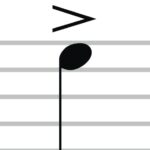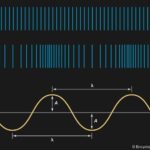If you can read a music sheet, you can easily sing a song correctly, even if you haven’t heard it yet. And one of the things that help you learn how to sing it with the right time measures is its music bars. What is a bar in music?
Music theory describes the bar as a single unit of time that contains a particular number of beats that musicians should play in a specific tempo. A vertical line represents the music bar that runs perpendicular to the staff. It indicates the start as well as the end of the measure.
Music composers use music bars to write their musical compositions. These bars are also called time measures, or simply measures, since they hold the information as to how long or how short the notes inside them are to be played. This is the way composers organize written music by dividing it into small segments.
Read on to learn more about music bars, what they are, their different types, and how to read and count them.
What Is a Bar in Music?

Single Unit of Time
The bar, in music theory, represents a single unit of time that holds a certain number of beats played at a specific tempo. In music circles, it is also commonly called a measure. Music bars are represented by vertical lines that are drawn perpendicular to the staff. They indicate where the measure starts and ends.
Tool to Organize Music in Small Sections
The music bar is an important element in written music. Composers organize their written music in small sections using this tool. Every bar in the music sheet represents a small amount of time. The bars in a music piece usually have the same number of beats.
For instance, music that beats like 1-2-3-4-1-2-3-4 is generally divided into several bars, each with four beats of time, in every bar.
Container That Holds a Set Number of Beats
You can consider a bar as a container that holds a set number of beats. The beats that each bar holds are defined by the time signature of the music piece. Common on many music pieces is the 4/4 time signature, which is called ‘common time.’
Vertical Lines Use to Divide a Musical Staff Into Measures
Additionally, music bars are the vertical lines that are used to divide a musical staff into measures. In any music where a grand staff is used, such as in piano music pieces, these music bars connect the staves through the entire composition. They are also called ‘systematic barlines.’
Grouping
A music bar can be comprised of four beats. It’s straightforward. Just counting 1, 2, 3, 4 will do it. For instance, if the standard pattern of the music sheet is “clap, kick, clap, kick,” that will give you a bar. Each time you need to repeat that pattern, you will have another bar.
The four beats in a bar represent a grouping. This grouping can be called either a bar or a measure. A music composer organizes a whole song or music piece by putting together all the bars that the music requires. They do it by forming large sections of music bars and then combining all these large sections into just one whole piece of music.
Bar and Measure Are Alike
An important thing that you need to understand in music is that a bar and a measure are alike. When musicians refer to a measure, they are talking about a small section of the music piece they are playing. That measure or bar holds a set number of beats.
Time Signature
This is all related to the time signature of the music piece. In a time signature, there is a number at the top and a number at the bottom. The number at the top tells you how many beats there are in a bar or a measure. And the bottom number tells you the kind of note that beat is for:
4/4 Time Signature
For example, if you have a 4/4 time signature, the four at the top means four beats in a measure or bar. The four at the bottom indicate that a quarter should receive that one beat.
3/4 Time Signature
In a 3/4 time signature, the three at the top means the bar has three beats in a measure, and the four at the bottom means one beat is to be given to a quarter note.
6/8 Time Signature
In a 6/8 time signature, the six at the top means the measure should have six beats, and the eight at the bottom indicates the eighth note should be given one beat.
What Is the Function of the Bar Line

Divides a Musical Staff Into Several Measures
In simple terms, bars in music sheets are vertical lines that divide a musical staff into several measures. Together with the horizontal staff lines, they keep track of where you are in the music piece. They work like the punctuations you see in written sentences.
To visualize the concept, consider the music staff as a timeline. This staff is usually divided into smaller segments or smaller units of time, just like what you have in a time clock, where hours are divided into minutes.
2. Help Count the Beats
So, the music bars help you count the beats and help you track and inform you where you are already in a music piece – as you play it from start to finish.
Similar to a Musical Paragraph
You can also think of a music piece as having sentences and paragraphs. So, a bar line, or a line with several bars, can be likened to a musical paragraph. The function of the bar line is to divide the entire music piece into measures (or bars). So, the musical paragraph is broken into smaller and measurable groupings of notes that you can easily track.
Musicians Use the Measure to Write Music
Every measure has a set number of beats. The most commonly used measure is comprised of four beats. Musical composers use the measure to write their music and organize them so that instrumentalists and singers can read, follow, and perform their music as they want it done.
Organizes an Entire Piece of Music Piece Into Smaller Groups of Notes
Bars or measures organize an entire music piece into smaller groups of notes. Four beats per measure is easy to count. It is ‘1, 2, 3, and 4,” and then repeat that same pattern in the succeeding measures until you finish the whole music piece or song.
A Standard Song Has Over 200 Individual Beats
To give you a bird’s eye view of an entire music piece, a standard song lasting about three minutes can have over 200 individual beats. If you don’t have something to organize these hundreds of beats, you will be hard-pressed to track your current place in the song.
Help Track Where You Are in a Song
So, measures or bars help you track where you are already in the song while singing it. Composers use them to break their musical creations into easily consumable segments. This practice allows the instrumentalists and singers to perform or sing the music as the composer intended it to be heard.
Practical for Composers and Performers
This is very practical, not only for the composers but more so for the performers. Instead of focusing their minds on the entirety of the music piece, they can isolate them in sections or segments to concentrate on how they can best deliver the music piece or song.
Again, what is a bar in music? A bar or measure is a segment of music or a single unit of time containing a certain number of beats, which musicians use in writing music. It is usually represented by a vertical line, which also indicates a measure’s start and end.
Different Types of Bar Lines and What They Mean

Music composers have come up with five different types of bar lines to organize their musical compositions. Each of these bar lines has its meaning. They communicate different things to the instrumentalists and singers:
1. Single Bar Line
The single bar line is the vertical line that is drawn perpendicular to the staff. Its main function is to tell the player or singer when to start and when to stop. But it’s only for that section. You have to go on and proceed to the succeeding bars. It also indicates the end of one bar and the beginning of another.
2. Double Bar Line
The double bar line is represented by two vertical lines that are side by side. This musical notation indicates the end of one section of the music piece and the beginning of another section. You need to play right past through this double bar line.
3. End Bar Line
The end bar line is indicated by two vertical lines close to each other. When you reach this part of a music piece, you have reached its end. There is a distinction between these two lines: the second line is thicker than the first line. The end bar line usually indicates the end of the whole musical piece. But it can also be used to indicate the end of a musical movement.
4. Start Repeat Line
The start-repeat bar line is indicated by double bar lines, where the first line is thicker than the second line. Then the double lines are followed by two dots similar to the colon, a punctuation mark.
When you see this line, it means you have to repeat every beat and measure inside of the two dotted double lines. This start-repeat line also shows the first bar of a section that was repeated.
5. End Repeat Line
The end-repeat line is also indicated by double bar lines, where the second line is thicker than the first line. A pair of dots that look like a colon also precede the double lines. This end-repeat line indicates the last bar of a section that was repeated.
Reading Bars
Musicians and singers read music bars from left to right. They play or sing the notes in sequence as they see them written in the music sheets. In reading the music bar, you need to understand and follow the time measure, the meter or tempo, and the value of the notes. All information contained in the music bar depends on the following:
1. Bar Lines
The different bar lines determine the player’s or singer’s performance of the music piece, from continuing, repeating certain sections, or ending the music piece altogether.
2. Time Signature
The time signature indicated in the starting bar line of a music piece determines the number of beats for each measure of the music. The most common time signature followed in the West is 4/4, where the four at the top indicate the beats per measure and the four at the bottom indicate the type of note given one beat. In this case, it is a quarter note.
3. Note Values
The individual notes inside a bar line also determine the duration or length of that bar should last.
4. Tempo
Usually, a whole music piece has one overall tempo. But there are many cases where different sections of a single piece of music can have different tempos. The tempo of a section determines the speed by which the instrumentalists or singers should deliver the notes in that section.
Generally, the tempo is given in beats per minute or BPM. Musicians use metronomes to help them follow the bpm or tempo required by a music piece.
Conclusion: What Is a Bar in Music?
As defined by music theory, the bar is the single unit of time that holds a set number of beats that should be played in a specific tempo. A vertical line is used to denote the music bar. This line runs perpendicular to the staff. It shows where the bar or measure should start and end.
These bars are also called measures because they contain how long or short each note should be played. So, music bars are used by composers to organize their musical compositions. They divide their compositions into small sections using these bars so that musicians can play them.
Related reading:
Sheet Music Plus Reviews [Is It Safe? Is It Worth It?]
Marcato – Music Definition – What Does Marcato Mean in Music?






![What Is Music Without Lyrics Called [and Popular Instrumentals] what is music without lyrics called](https://musicalinstrumentpro.com/wp-content/uploads/2022/09/what-is-music-without-lyrics-called-150x150.jpg)


